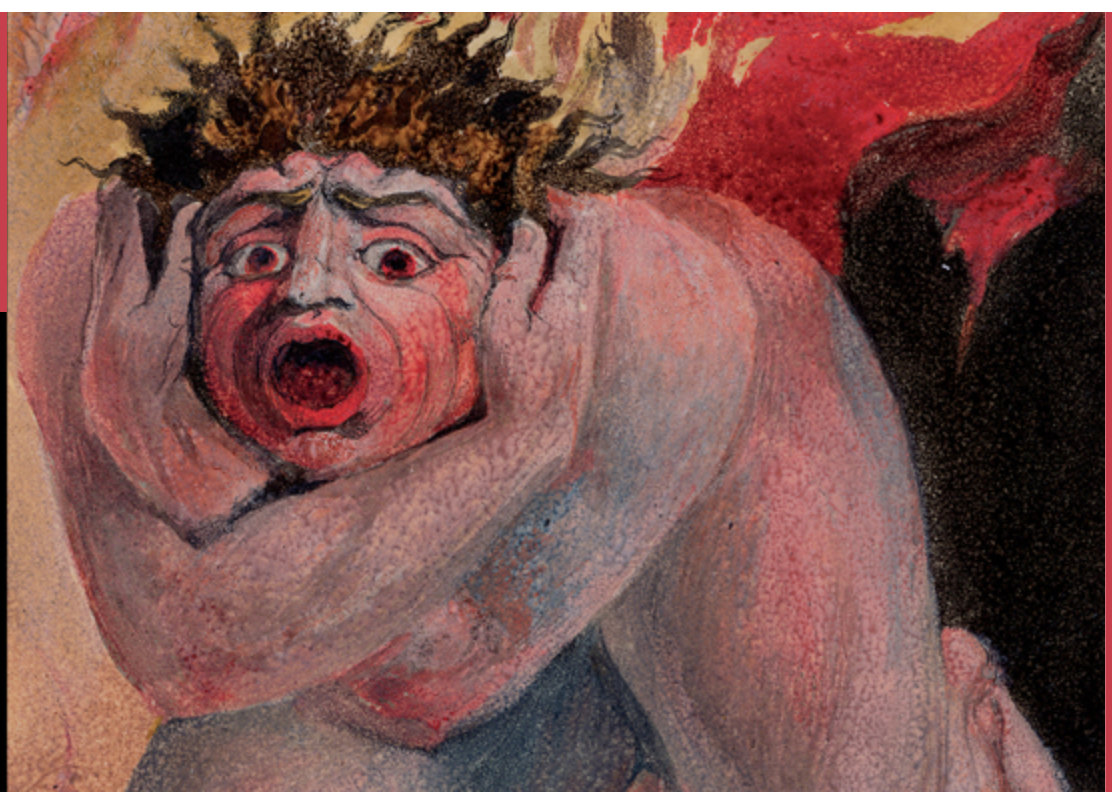Jan 18th Dark dark dark
I have had a heavenly week, if god be in the details, dealing with details of the dark. And this despite losing two days to personal uses. The days were lost to the laboratory but gained for the home: My mom was in Oxford and Laura and I visited her. Had a guided tour of the Bodleian Library, staggered around Pitt Rivers Museum, and oggled the Blake show at the Ashmolean. Blake is titanic and my jaw was often near the floor, but for what it is worth the curation was tedious, adding nothing. Besides A-list Oxford sights, plenty of Mommery!

Detail of a monotype by William Blake.
From the current show at the Ashmolean Oxford. http://www.ashmolean.org/exhibitions/williamblake/
But the lab was not neglected entirely. Happily, the temperature record revealed steady temperature, plus or minus a quarter ˚C, from mid-November when I turned it on to now. Phew! But, this rules out a sudden cold spell as an explanation for week-before-last’s worthless maize growth. The batch for last week were right on the money, in terms of growth, although the germination defect remained. This suggests that week before last, I got cyanide in my seeds, or something equally untoward. Have to keep an eye on that.
But with some actual plants last week, I was able to try cutting them up in the dark, aided by the sniper-scope. Laura’s black shroud worked well and I could see what I was doing well enough. The shroud needed adjustment. I had to glue the corners to the head strap, so that it would curl around my face, rather than falling away. And I had to cut a hole in its face to allow the ocular of the sniper-scope to reach my eye. This is arguably the weak link – it ought to be some kind of properly constructed sleeve thing. But it might do with tape. It depends how well it stands up to being put on and off time after time.
Naturally, these advances brought me up against a fresh problem: seeing the computer. To do these experiments, I have to capture an initial image, at time zero, and then a final one, at some later time, let’s say 4 hours later (long enough to measure growth reliably). I have been planning to have the computer in the dark corridor, just outside the light-tight growth chamber door. That way, I place the washer-plate of segments in the camera rig, and then go outside the chamber to access the computer. The corridor is totally dark, and I can toggle the screen on and off, so the computer will be dark too.
What I expected to do was to leave the chamber, toggle the computer screen on, capture the image, toggle the screen off, and go back into the chamber to set up the next plate of segments. And so on. But the needle in this particular fingertip is the sniper-scope. There are warnings all over its packaging and manual to avoid bright light at all costs. It is designed for darkness (in the visible spectrum). What is more, the numbers of infrared photons are few compared to the millions shooting out of a computer screen. OK, fine: I had been imagining protecting the sniper-scope by putting on its lens cap before emerging from the chamber and seeing the screen with my other eye. But ha ha, my other eye is now hidden behind the Laura-shroud. Ooops.
I could take the sniper scope on and off, but this is rather a pain. The next question is: Can I capture images without using the computer screen, by keystroke only? This is a tad dangerous because if things clicked up wrong, I’d have no images, losing the experiment. So it has to be foolproof. On a computer? Right. Well? Maybe. It looks like the micromanager software I have installed to drive the camera has a snap image into an “album” function that might work. An album sounds like a seaside vacation! I found out about it over the weekend after I posted a query to the micromanager list-server (yes, such a thing exists and I got an answer a mere few hours after posting, on a Friday no less). I had spent many frustrating minutes trying to snap images successively, with no luck. But I didn’t know about this album thing. This week, I’ll see how this album function pans out.
In other news, relating to the other project, namely analyzing the root’s velocity profile, Mike Pound here at CPIB helped fix up a glitch in the stripflow code. I’ll explain the details later but just to say here that I had time last week to test his version out and it works. The new code won’t overturn anything I have done before, the glitch was subtle, but it will help me push the accuracy of the data I am collecting. I have some nice fast wild-type roots waiting in the wings to be crunched and it will be interesting to see how they do. Stay tuned for more of those heavenly details on root velocity profiles.